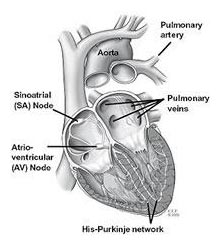
Atrial Fibrillation
Introduction – The Normal Heart Rhythm
The heart is an electro-mechanical pump. It has two upper chambers called atria and two lower chambers called ventricles. Perfectly timed contractions of upper chambers and lower chambers maintain efficient pumping action of the heart. This results in distribution of adequate blood to all parts of the body. The timing and sequence of heart contractions are controlled by the electrical system of the heart.

The electrical impulse begins in the Sinoatrial (SA node), located in the right atrium. It is called the pacemaker of the heart. The SA node increases the rate of impulses during exercise and decreases the rate of impulses during sleep.
Atrial Fibrilation
Normally, all muscle fibers of the atria get electrically activated in a sequence, and all fibers contract at a time to maintain forward flow of blood and emptying of the blood into the ventricle. When different muscle fibers contract or relax at different times due to abnormal electrical autonomic foci, effective forward flow of blood cannot be maintained.
Atrial fibrillation is the most common irregular heart rhythm. It starts in the atria. Instead of one impulse being generated by the SA node, many autonomous foci develop in different portions of the atria.This leads to mechanical dysynchronous contractions of individual muscle fibres of the atria.
The atria is seen to be only shivering and not effectively contracting as one unit leading to a chaotic rhythm

When the ventricles contract irregularly it leads to rapid and irregular heartbeat. The rate of impulses in the atria can range from 300 to 600 beats per minute, but all impulses are prevented from reaching the ventricle by a structure called AV node.
Types Of Atrial Fibrilation
There are two types of atrial fibrillation
Paroxysmal – intermittent (it comes and goes)
Continuous – persistent
Atrial fibrillation can be threatening. When there is no effective contraction of the atria, owing to stasis of blood, it ends in the formation of clots. They can travel to any place in the body like brain (leading to stroke), kidneys, intestines, etc; and cause damage to those structures. Atrial fibrillation is associated with an increased risk of stroke, heart failure and even death.
Causes
In most cases, atrial fibrillation is caused due to a preexisting heart condition.
- Coronary artery disease
- Hypertension (high blood pressure)
- Chronic lung disease
- Cardiomyopathy
- Heart failure
- Congenital heart disease
- Heart valve disease
- After heart surgery
- Pulmonary Embolism
- Thyroid disease
- Pericarditis
- Viral infection
However, in 10 – 15% of the cases, it occurs with no underlying heart disease. In such cases, it may be related to any of the following
- Alcohol or excessive caffeine use
- Stress
- Specific drugs usage
- Electrolyte or Metabolic Imbalances
- Severe infections
- Genetic factors
- Age (particularly after 60)
Symptoms
- Heart palpitations: Sudden pounding, fluttering or racing sensation in the chest
- Lack of energy
- Dizziness with or without fall in blood pressure
- Chest discomfort: Pain, pressure or discomfort in the chest
- Shortness of breath: Having difficulty breathing during normal activities and even at rest
Sometimes, it may also present with absolutely zero symptoms
Diagnosis
Electrocardiogram (ECG)
Holter monitor: It is a wearable ECG recorder and records the ECG for 24 to 48 hours. This is useful when the atrial fibrillation occurs intermittently.
Event Loop Recorders: These can record ECG for a longer period of time like 7 to 10 days. They alert the occurrence of abnormal beats and the information can be received by E-mail/SMS.
Management
Managing Atrial fibrillation consists of
- Restoring normal heart rhythm (sinus rhythm)
- Controlling the heart rate
- Thinning of blood to prevent formation and migration of blood clots and reducing the risk of stroke
Lifestyle Changes
- Stop Smoking
- Moderate alcohol intake
- Avoid use of caffeine or caffeinated products (tea, coffee, energy drinks, coca-cola)
- Control blood pressure
- Achieve desirable weight
- Control blood sugar levels
- Look out for sleep apnea
Procedures
When medications are ineffective in achieving rate control or rhythm control or are not tolerated, the following alternatives are considered
- Electrical cardioversion
- Pulmonary vein isolation
- Surgical ablation (Maze procedure)
- Left atrial appendage closure by surgery or watchman device
Dr Venkatesh T K
Associate Consultant
Department of Cardiology
UPDATED ON 03/09/2024
Apollo Highlights & Updates
 Apollo Hospitals takes up a 4.5-Hour Stroke Treatment Promise with Advanced Stroke Care Network with Extended 24-Hour Tr...
Apollo Hospitals takes up a 4.5-Hour Stroke Treatment Promise with Advanced Stroke Care Network with Extended 24-Hour Tr...© Copyright 2024. Apollo Hospitals Group. All Rights Reserved.
 +91 8069991061
Book Health Check-up
Book Health Check-up
Book Appointment
Book Appointment
+91 8069991061
Book Health Check-up
Book Health Check-up
Book Appointment
Book Appointment








